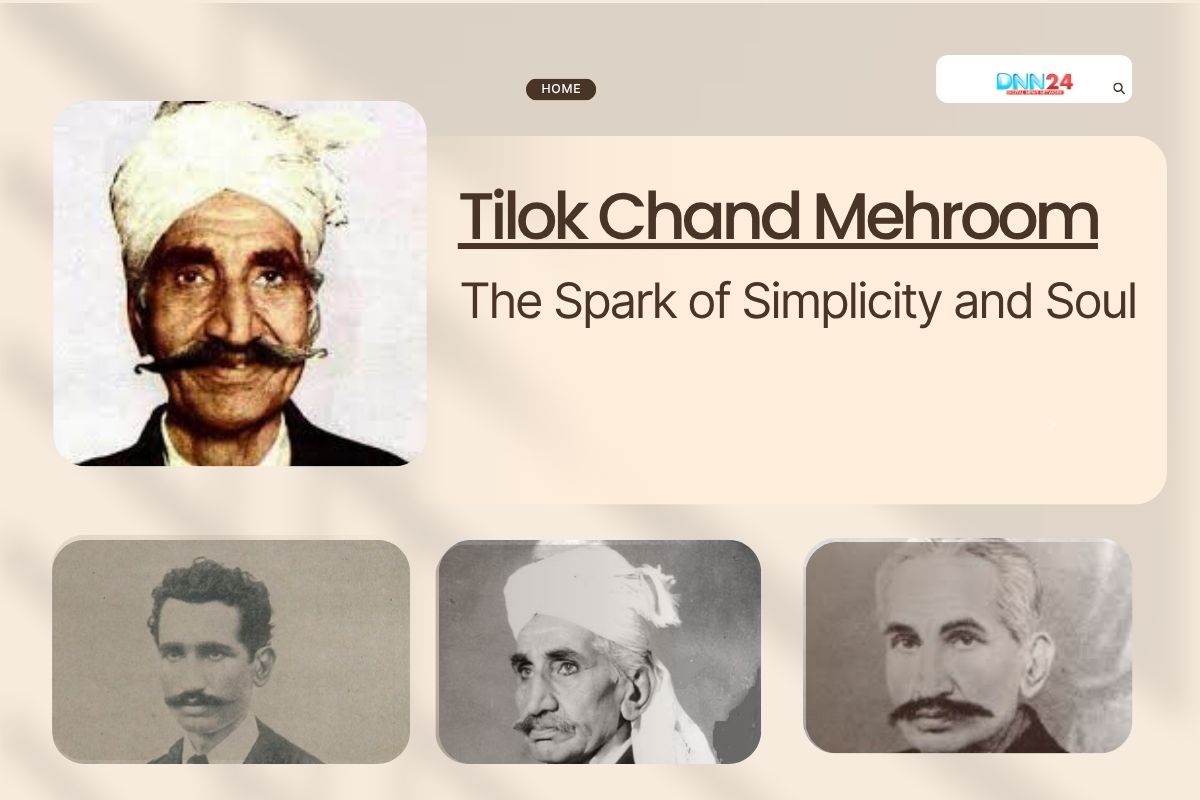It is a village where they know every smile, every sigh and where the pulse of life is the roar of the great river Indus and yet the gentleness of the river can turn to violence and can flood and wash away the dreams of centuries. This was the birthplace of Tilok Chand Mehroom in Mauza Zaman Shah, Mianwali District, Punjab (now in Pakistan), in 1887. Think of a frail boy, Mehroom, who saw his house, and all the dreams which it contained, being washed away by furious floods.
nazar uTha dil-e-nadan ye justuju kya hai
Tilok Chand Mehroom
usi ka jalwa to hai aur ru-ba-ru kya hai
One hears tales–never written in schoolbooks–of a weak lad who wrote poems on the school walls as the river whispered to him. It was a ladder to his dreams when he wrote his first poem at the age of 12 years and was commended by both the Divisional Inspector and the Director of Education. Tilok Chand Mehroom did not become bitter because of loss and insecurity. Rather, his empathy and sense of justice were shaped by the floods and remained there to tint his subsequent poetry with an unusual amount of humanity.
Growing Up with Shadows: the Student and the Silent Storyteller
Lots of poets get their inspiration from libraries, where the classics weigh down the shelves. The situation of Mehroom is different; his school lacked a good library. Books were treasures, and scarce as summer rain. But this drought of stories, young Tilok Chand did his spinning. He read all the valuable pages he could get–particularly of Mirza Ghalib and Mohammad Ibrahim Zauq. Every borrowed book, every worn-out verse, marked an insatiable thirst for literary eminence.
kya sunaen kisi ko haal apna
Tilok Chand Mehroom
apne dil mein rahe malal apna
There is a story that has been told and re-told and written and re-written: when Mehroom was a teenager, she composed an elegy on the death of Queen Victoria in 1901. They were mostly seeing a young colonial subject paying homage, but in reality, it was an intelligent mask. His poems were lamentations over the queen, and the changing fortunes of his own country–grief, homesickness and endurance. His secret was that he wrote so that all the tears that were shed were shed into the river–the reader could not know whether the sorrow was that of a king or that of some unknown mother by the Indus.
sharmsar-e-jawab ho na saka
Tilok Chand Mehroom
bas-ki KHuddar tha sawal apna
The Teacher Who Wrote on Young Minds and Old Walls
When Mehroom joined Mission High School, Dera Ismail Khan, as a teacher, he was 21 years old. Picture the scene: a mild, spectacled man with chalk in his hand, speaking his voice with a mixture of Urdu couplets and English grammar, always looking out to the shy, silent children who looked to him like himself. Students loved him because he was empathic and could listen to them.
is ka gila nahin ki dua be-asar gai
Tilok Chand Mehroom
ek aah ki thi wo bhi kahin ja ke mar gai
Yet outside the classrooms, he was restless. Mehroom used to change schools often, and in some cases, due to personal reasons, and in other cases, because he wanted everyone to have clean water. At Kaloorkote, he was not merely a headmaster. It is a charming legend,–upon which it is often related in old Rawalpindi,–that the children used to hear his poetry resounding in the laughter of the wind, and to learn by heart one of his shayaris, which could dissipate fears, or crown successes:
“Ai ham-nafas na puchh jawani ka majra,
Tilok Chand Mehroom
Mouj-e-nasim thi idhar aai udhar gai”.
His poems started to be published in such journals as Makhzan and Zamana, which gained him admirers. Every annual mushaira (poetry gathering) in Rawalpindi and Lyallpur found him surrounded by legends. His trademark developed simplicity that was not simple-minded, emotion that was real and relatable. He was able to bring hope even at times when he was grieving, and he was able to put words together that became a soothing balm to the heart.
dam-e-gham-e-hayat mein uljha gai umid
Tilok Chand Mehroom
hum ye samajh rahe the ki ehsan kar gai
The Heartbreak Storyteller: The Time when Words Turned into Tears
One of the most heart-touching works of Mehroom is his book Toofan-e-Gham- his own Storm of Sorrow. Mehroom, whose pen was bent downward towards the well of heartbreak, lost his wife suddenly. He did not deny the existence of his pain; he used it as a form of healing for other people. His poem “Ashk-e-Hasrat” (Tears of Longing) is a testament to the power of vulnerability. Readers mutter that he once told a friend: when he wrote that poem, it seemed to him that each word fell like a tear out of his body, each word was a prayer to those too timid or too manly to weep aloud.
jab wo surat nazar nahin aati
Tilok Chand Mehroom
kab meri aankh bhar nahin aati
His poems are sad, yet they never leave a person desperate. Always there is a turn,–every sigh conceals a promise of tomorrow. Even when it fails or breaks apart, Mehroom has the poems to calm: “Sheher se aik taraf door bahut”–sometimes relief is to be had far away in the busy world, alone under the sky.
The Honoring Every Heart: Poems to Children and the Common Soul
What is most special about Mehroom is that he loved both adult readers and children. His books, such as Bacchon Ki Duniya and Bahaar-e-Tifli, are full of mischievous wisdom, tales that make small hearts grow bold, inquisitive and nice. The former students of Camp College, Delhi, recalled Mehroom as not a strict teacher but the Poet Uncle whose classroom was a garden of tales.
jalwaon se ayan jin ke hua tur ka aalam
Tilok Chand Mehroom
turbat pe hai un ke shab-e-daijur ka aalam
Among the stories that are not frequently heard: when Mehroom moved to Delhi in 1947 after Partition, he found refugee children terrified and lost. He would take them and he would read nazms to them, which drew rainbows after the rain, poems that would make children who had lost their homes laugh and feel at home, even just temporarily. Other poems were written on pieces of paper and distributed, like small lanterns, to banish their darkness.
KHatm hua din suraj Duba
Tilok Chand Mehroom
sham hui aur ubhre tare
jagmag jagmag karte aae
nur ke TukDe pyare pyare
According to him, children did not childishly write Shayari; it was a seed that grew into a forest of strong and hopeful minds. No wonder, then, that his patriotic poems—in the key of Suroor Jehanabadi—were always popular at all school functions and awoke the flame of patriotism in the hearts of the minute citizens.
The Covert Heartbeat- A Heritage of Honesty More Than Fame
Mehroom lives a song of simple honesty in a world that is more likely to reward bling. He did not like religious discrimination, and so he could not just talk about it, but rather his deeds. He made his decisions on principle at every turn-changing jobs, cities, even countries, because of a cause dear to his heart.
anjum se baDh ke tera har zarra zau-fishan hai
Tilok Chand Mehroom
jalwon se tere ab tak husn-e-azal ayan hai
He did not keep his life’s work in closed cabinets but shared a lot of it. His son Jagan Nath Azad gave away Mehroom’s treasured book collection to the Allama Iqbal Library in Kashmir so that future generations could touch his legacy. Whenever asked about missed glory, At the conclusion of an incendiary public discussion of the future of India, they say, Mehroom quieted the audience with one couplet—all fell silent and were reminded that poetry, like life, is in search of bridges rather than walls. Today, as well, teachers of Urdu literature secretly teach students that greatness is not to be known but to know the needs and feelings of others first.
andaz-e-dil-farebi jo tujh mein hai kahan hai
Tilok Chand Mehroom
faKHr-e-zamana tu hai aur nazish-e-jahan hai
Mehroom and His Mirror: The Way His Poems Reflect Us All
To read a ghazal or nazm by Tilok Chand Mehroom is to see yourself—not as a perfect statue, but as a living mosaic of joys, hurts, mistakes, and hopes. He talks about the ordinary things: mothers waiting for sons, solitary travelers, children restoring their houses after every storm. His poems are not scolding or lecturing.
ai sansar banane wale
Tilok Chand Mehroom
suraj ko chamkane wale
KHak se phul ugane wale
dariyaon ko bahane wale
In his poem “Saf aata hai nazar anjam har aaghaz ka, Zindagani maut ki tamheed hai mere liye” (“Every beginning reveals its end to me, life is just a preface to death”), one finds the courage to face all endings—knowing that within every sunset is the promise of a new dawn.
Saaf aata hai nazar anjaam har aaghaaz ka
Tilok Chand Mehroom
Zindagani maut ki tamheed hai mere liye
The Never-ending Story: Motivating the world in silence
Tilok Chand Mehroom lives this world in 1966, leaving behind more than collections and citations—he left a living pulse. His unmatched story of overcoming a tragedy in a flood-affected village to the heartbeats of schoolyards and crowded mushairas gives hope to anyone who has ever lost, felt lonely, or missed something but still had a dream. His poems are guidebooks to the lost, songs to the love-sick, and sunshine in the hands of children.
suraj ke dam-qadam se
Tilok Chand Mehroom
raushan jahan hai sara
hai is ki raushni se
dilkash har ek nazzara
So what is actually the true, untold story of Mehroom? It could be because he showed us: the real strength lies in simplicity, and the best poetry of life is always lived and not just written. His modest ink keeps the thousand lamps of hope burning and telling all generations: Onward. Rivers that drown your past can bring dreams to new shores too.”
Also Read: Munawwar Rana: The Poet Who Wrote the World’s Tears
You can connect with DNN24 on Facebook, Twitter, and Instagram and subscribe to our YouTube channel.

